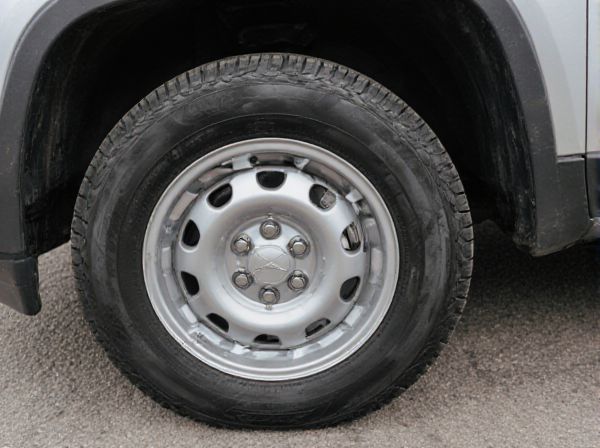
Photo illustration: Barrel vs Drop Center
Barrel and drop center wheels differ mainly in their rim design, affecting tire fitment and vehicle performance. Barrel rims have a smooth, continuous curve, providing strong support for wider tires, while drop center rims feature a groove that makes mounting and dismounting tires easier. Your choice between barrel and drop center rims should depend on the type of tire you use and your driving needs.
Table of Comparison
| Feature | Barrel Wheel | Drop Center Wheel |
|---|---|---|
| Rim Design | Uniform rounded rim shape | Central rim drop creating a valley |
| Tire Mounting | Simple, easier tire installation | Requires tire bead to drop into center for mounting |
| Common Usage | Older car models, vintage wheels | Modern vehicles, standard wheels |
| Performance | Stable, suited for narrow tires | Improved tire seating and sealing |
| Manufacturing Complexity | Simple manufacturing process | More complex due to rim drop contour |
Overview of Barrel vs Drop Center Wheels
Barrel wheels feature a consistent curved rim that provides enhanced strength and a smooth ride, making them ideal for heavy-duty and off-road vehicles. Drop center wheels have a recessed center section allowing easier tire mounting and removal, commonly used in passenger cars and light trucks. Each design optimizes performance based on vehicle requirements, balancing durability and maintenance convenience.
Key Design Differences
The key design difference between barrel and drop center wheels lies in their rim profiles: barrel rims feature a rounded, continuous curve ideal for mounting tires without a sharp central well, enhancing structural integrity. Drop center rims have a distinct central depression that simplifies tire installation and removal by creating extra clearance for the tire bead. Barrel rims are often preferred for heavy-duty use due to their strength, while drop center rims provide easier maintenance and tire changes, favored in passenger and performance vehicles.
Structural Strength Comparison
Barrel rims exhibit greater structural strength than drop center rims due to their uniform curvature, which evenly distributes stress and resists deformation under heavy loads. Drop center rims have a recessed middle section designed for easier tire mounting but create stress concentration points that can weaken the rim under high torque or impact. Engineers prefer barrel rims for off-road and heavy-duty vehicles where enhanced durability and resistance to bending are critical for performance and safety.
Performance and Handling Impacts
Barrel tires offer increased traction and better handling on uneven or off-road surfaces due to their aggressive tread and sidewall design, enhancing vehicle stability during sharp turns and rugged conditions. Drop center tires provide smoother performance on paved roads, improving fuel efficiency and ride comfort by minimizing rolling resistance and optimizing tire contact with the road. Selecting between barrel and drop center tires directly influences vehicle responsiveness, cornering ability, and overall driving dynamics based on the terrain and driving requirements.
Suitability for Different Vehicle Types
Barrel wheels are generally suitable for heavy-duty vehicles like trucks and SUVs due to their enhanced strength and ability to handle higher loads, providing durability on rough terrains. Drop center wheels are more common in passenger cars and light vehicles, offering easier tire mounting and balancing, which improves ride comfort and fuel efficiency. Choosing between barrel and drop center wheels depends on vehicle weight, usage conditions, and maintenance preferences to ensure optimal performance and safety.
Ease of Tire Mounting and Removal
Barrel rim design features a uniform curved profile that provides smooth tire mounting and removal, reducing the risk of tire bead damage. Drop center rims have a recessed central groove that aids in dropping the tire bead during installation or removal, making the process quicker and less labor-intensive. For ease of tire mounting and removal, drop center rims are generally preferred in automotive applications due to this built-in bead seating advantage.
Cost and Maintenance Factors
Barrel rims typically cost more due to their complex manufacturing process but offer enhanced durability, reducing long-term maintenance expenses. Drop center rims are generally less expensive upfront and easier to replace, though they may require more frequent repairs depending on usage conditions. Evaluating cost-efficiency involves balancing initial investment against anticipated maintenance frequency and durability specific to each rim type.
Pros and Cons of Barrel Wheels
Barrel wheels, characterized by their curved, convex shape, offer excellent grip and stability on soft or sandy terrains, making them ideal for off-road and agricultural uses. Their design distributes weight evenly, reducing soil compaction and improving traction, but they tend to be heavier and less efficient on hard, paved surfaces compared to drop center wheels. However, barrel wheels require more maintenance due to their complex structure and can result in higher fuel consumption because of increased rolling resistance.
Pros and Cons of Drop Center Wheels
Drop center wheels offer improved ease of tire mounting and removal due to their recessed center design, making them ideal for quick maintenance and tire changes. They provide enhanced compatibility with modern tires and vehicles, supporting better performance and tire seating. However, drop center wheels may be less durable under heavy loads compared to barrel wheels and can be more prone to damage in off-road or rugged conditions.
Choosing the Right Wheel Type
Selecting the right wheel type hinges on understanding the structural differences between barrel and drop center wheels. Barrel wheels feature a cylindrical shape that offers better load distribution and strength, making them ideal for heavy-duty applications and off-road vehicles. Drop center wheels, characterized by a recessed center section, simplify tire mounting and are preferred for passenger cars due to their ease of maintenance and wide compatibility.
 caratoz.com
caratoz.com